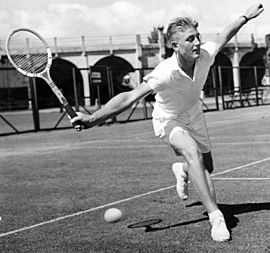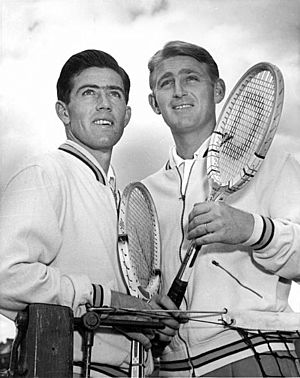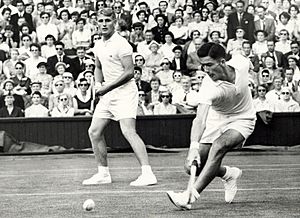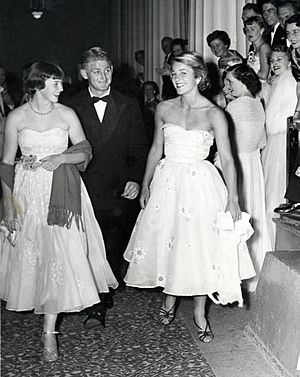Lew Hoad facts for kids
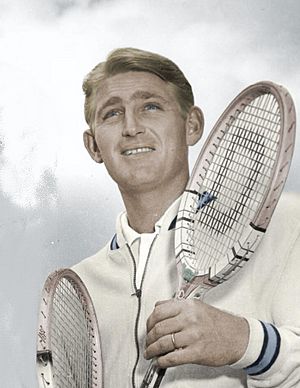
Hoad at the 1954 Davis Cup
|
|
| Full name | Lewis Alan Hoad |
|---|---|
| Country (sports) | |
| Born | 23 November 1934 Glebe, Australia |
| Died | 3 July 1994 (aged 59) Fuengirola, Spain |
| Height | 1.79 m (5 ft 10+1⁄2 in) |
| Turned pro | 1957 (amateur tour from 1950) |
| Retired | 1972 |
| Plays | Right-handed (one-handed backhand) |
| Int. Tennis HoF | 1980 (member page) |
| Singles | |
| Career record | 824–503 (62.1%) |
| Career titles | 52 |
| Highest ranking | No. 1 (1953, Chatrier) |
| Grand Slam singles results | |
| Australian Open | W (1956) |
| French Open | W (1956) |
| Wimbledon | W (1956, 1957) |
| US Open | F (1956) |
| Professional majors | |
| US Pro | F (1958, 1959) |
| Wembley Pro | F (1961, 1962, 1963) |
| French Pro | F (1958, 1960) |
| TOC | W (1958, 1959) |
| Doubles | |
| Grand Slam doubles results | |
| Australian Open | W (1953, 1956, 1957) |
| French Open | W (1953) |
| Wimbledon | W (1953, 1955, 1956) |
| US Open | W (1956) |
| Grand Slam mixed doubles results | |
| Australian Open | F (1955) |
| French Open | W (1954) |
| Wimbledon | SF (1953, 1954, 1955) |
| US Open | F (1952, 1956) |
| Team competitions | |
| Davis Cup | W (1952, 1953, 1955, 1956) |
Lewis "Lew" Alan Hoad (born November 23, 1934 – died July 3, 1994) was an Australian tennis superstar. He played tennis from the early 1950s until the early 1970s. Hoad won four major Grand Slam tournaments as an amateur player. These included the Australian Open, the French Open, and Wimbledon twice. He was also a key member of the Australian team that won the Davis Cup four times between 1952 and 1956.
Hoad became a professional tennis player in July 1957. He won the Kooyong Tournament of Champions in 1958 and the Forest Hills Tournament of Champions in 1959. He was ranked as the world's No. 1 tennis player by different experts in 1953, 1956, 1959–1960, 1961, and 1962. He still holds the record for the youngest male player to be ranked world No. 1, which he achieved in 1953 at just 19 years old.
Sadly, Hoad suffered from serious back problems throughout his career, especially after he turned professional. These injuries led to him mostly retiring from tennis in 1967. After his full retirement in 1972, Hoad and his wife, Jenny, opened a tennis resort called Lew Hoad's Campo de Tenis in Fuengirola, Spain. Lew Hoad passed away in 1994 from leukemia.
Contents
Early Life and Start in Tennis
Lewis Hoad was born on November 23, 1934, in Glebe, a working-class suburb in Sydney, Australia. He was the oldest of three sons. Lew started playing tennis at age five with a racket given to him by a local club. As a young boy, he would wake up early, sometimes at 5 a.m., to hit tennis balls against a wall or garage door. He later practiced on the courts of the Hereford Tennis Club, which was behind his house. When he was 10, he played in a tournament in Manly in the under-16 age group.
In his youth, Hoad often played against Ken Rosewall, who would become a lifelong friend and rival. They were known as the "Sydney twins," even though they looked and played very differently. Their first match was in 1947 when they were both 12. Rosewall won that match easily. Hoad became very strong, especially in his hands and arms, by training at a police boys' club where he also became a good boxer.
When Hoad was about 12, he met Adrian Quist, a former Australian tennis champion. Quist was impressed by Hoad's natural talent. At 14, Hoad left school and started working for the Dunlop sports company. This was common back then for talented young tennis players in Australia. In November 1949, Hoad won the junior title at the New South Wales Championships. He also competed in the junior table tennis championship final that same weekend.
Amazing Amateur Career (1951–1957)
First Steps in Grand Slams (1951–1952)
Hoad's first appearance in a Grand Slam tournament was at the 1951 Australian Championships in January. He won his first match but then lost to the defending champion, Frank Sedgman. This was his only Grand Slam that year. In August 1951, Hoad won his first men's singles title at the Brisbane Exhibition tournament, beating Rosewall in the final.
In 1952, Hoad reached the third round of the Australian Championships. He was chosen to play in overseas tournaments. Before going to Europe, he won the Australian Hard Court Championships on clay, again beating Rosewall in a tough final. He played in the French Championships for the first time but lost early. However, he and Rosewall reached the doubles semifinal there. At Wimbledon, Hoad reached the fourth round in singles and the semifinals in doubles with Rosewall. Later that year, he reached his first Grand Slam quarterfinal in singles at the U.S. Championships. He also made it to his first Grand Slam final in mixed doubles. By September, he was ranked No. 10 in the world.
Rising to World No. 1 (1953)
Hoad had a mixed start to 1953, losing early in singles at the Australian Championships. But he and Rosewall became the youngest team to win the Australian doubles title. He successfully defended his Australian Hardcourt singles title. In Europe, he reached the final of the Italian Championships and won the doubles title with Rosewall. At the French Championships, he and Rosewall won the doubles title. Hoad then won the Queen's Club Championship, a key warm-up for Wimbledon. At Wimbledon, he and Rosewall won their third Grand Slam doubles title of the year.
Back in Australia, Hoad won the Queensland and New South Wales Championships. The Davis Cup final against the United States was a highlight. Hoad defeated his rival Vic Seixas in singles. Australia was behind 1–2, but Hoad played an amazing five-set match against U.S. champion Tony Trabert to help Australia win the Cup. This match is remembered as one of the best in Davis Cup history. After this, Hoad was called up for National Service. He was ranked world No. 1 for 1953 by Tennis de France, becoming the youngest player ever to reach this spot at 19 years and 38 days old.
Challenges and Comebacks (1954–1955)
In 1954, Hoad's tennis was affected by his National Service training. He even got sick after a spider bite. During his service, he started a weight-lifting exercise that he later thought might have caused his back problems. He won the mixed doubles title at the French Championships with Maureen Connolly. He also defended his Queen's Club title. However, he lost early in Wimbledon and the U.S. Championships. His form was inconsistent, and he was even booed by crowds at times. Australia lost the 1954 Davis Cup to the United States. His world ranking dropped to No. 7.
In 1955, Hoad had a torn ligament, but still reached the mixed doubles final at the Australian Championships with his girlfriend, Jenny Staley. He made it to his first Grand Slam singles final at the Australian Championships but lost to Rosewall. Australia had to fight through preliminary rounds to challenge the U.S. for the Davis Cup. Hoad played a crucial role, winning his singles match against Trabert and the doubles with Rex Hartwig, helping Australia reclaim the Davis Cup. At the U.S. Championships, he lost to Trabert in the quarterfinals. He finished the year strong, winning the New South Wales and Victorian Championships. He was ranked No. 3 in the world.
Grand Slam Success and Turning Pro (1956–1957)
Hoad started 1956 by winning his first Grand Slam singles title at the Australian Championships, beating Rosewall in the final. He also won the doubles title with Rosewall. He then won the French Championships, his second Grand Slam singles title. He continued his winning streak at the Wimbledon Championships, becoming the pre-tournament favorite and winning his first Wimbledon title against Rosewall. He also won the doubles title with Rosewall. This meant he had won three Grand Slam singles titles in a row!
Hoad was hoping to win all four Grand Slams in 1956, but he lost in the final of the U.S. Championships to Rosewall. He and Rosewall did win the doubles title there. After Wimbledon, Hoad started having severe back pain, which affected his play for the rest of the year. Despite this, he was part of the Australian team that successfully defended the Davis Cup against the United States. He won both his singles matches and his doubles match. Hoad was ranked world No. 1 by Lance Tingay and Tennis de France for 1956.
In early 1957, Hoad's back problems continued, and he had to wear an upper body cast for six weeks. After recovering, he won his second straight Wimbledon singles title, beating Ashley Cooper in a quick final. After this victory, Hoad decided to become a professional tennis player. He signed a two-year contract for a record amount of money.
Professional Career (1957–1972)
Adjusting to Pro Tennis (1957–1958)
When Hoad turned professional in July 1957, he played his first pro match against Frank Sedgman at the Forest Hills Tournament of Champions. He won that match. He noted that professional tennis was "an entirely different league" because pros made fewer mistakes on important points. His coach, Jack Kramer, felt Hoad needed to improve his second serve.
In 1958, Hoad began a series of head-to-head matches against the top professional player, Pancho Gonzales. Hoad started strong, leading 8–5 in Australia and New Zealand. He even had a 15–3 winning streak against Gonzales at one point. However, Hoad's back problems returned, especially after a chilly outdoor match in Palm Springs. He had to take time off to rest. In the end, Gonzales won the series 51 matches to 36.
Despite the tour loss, Hoad won the Kooyong Tournament of Champions in Melbourne in January 1958, which was the richest tournament that year. He also reached the final of the French Pro Championship but had to stop playing well due to his back. He also had to miss the Wembley Pro tournament because of his "arthritic" back.
Winning the Ampol World Series (1959)
In 1959, an Australian oil company, Ampol, created a "world series" of tournaments with a point system to find the best player. Hoad started slowly due to an elbow injury but then won tournaments in Perth and Adelaide. He took the lead in the Ampol bonus points and kept it until the series ended in January 1960.
On the 1959 Kramer World Professional Championship Tour, Hoad had a winning record against Gonzales (15–13). He also beat the new pros, Ashley Cooper and Mal Anderson. However, his back trouble continued. He won the Forest Hills Tournament of Champions in June, beating Rosewall and Gonzales. This was seen as a major moment, with many saying it marked the end of Gonzales's dominance. Tennis journalist Joe McCauley called this the peak of Hoad's career.
The Ampol Open Trophy series finished in Australia. Hoad won the Perth and Adelaide events. Gonzales left early for the holidays, which meant Hoad won the overall Ampol Open Trophy and the bonus money. Hoad finished first in the series with 51 points, ahead of Gonzales (43 points) and Rosewall (41 points). Many news outlets called Hoad the "new world professional tournament champion" and the "world's top professional tennis player."
Later Pro Years and Retirement (1960–1972)
In 1960, Hoad took a three-month break to rest his back and spend time with his family. When he returned, he was a bit out of shape but slowly got back into form. He won tournaments in New Zealand, Santa Barbara, and Geneva. He also won the first Japanese Professional Championships in Tokyo, beating Rosewall in a very long five-set final.
In 1961, Hoad had to withdraw from a tour due to a broken left foot. After recovering, he played a ten-match series against Gonzales in Britain and Ireland, winning six of the ten matches. He reached the final of the Wembley Pro but lost to Rosewall. He also helped Australia win the first Kramer Cup (a pro version of the Davis Cup).
In 1962, Hoad won the Adelaide Professional Championships and a pro tour in Italy. He was voted the world No. 1 tennis player for 1962 by a poll of 85 U.S. sports editors. In 1963, Hoad and Rosewall helped sign new pro Rod Laver. Hoad beat Laver 8–0 in an Australian tour, showing his continued strength. However, Hoad then suffered a shoulder injury and was inactive for five months. He reached the final of the Wembley Pro again but lost to Rosewall.
From 1964 to 1967, Hoad continued to struggle with injuries, including foot problems. In early 1965, part of his right toe was removed. He played less often. In 1966, he had his last victory against Laver in Sydney. After his contract ended in November 1966, Hoad took a ten-month break from competitive play.
He made a surprise return for the Wimbledon Pro tournament in August 1967, which was a trial for "open" tennis (allowing both amateurs and pros to play). Despite being semi-retired, he beat 39-year-old Gonzales in a match that a BBC commentator called "the finest match ever seen on these hallowed grounds." This was their last match on grass, with Hoad having a better record against Gonzales on that surface. Hoad then retired permanently from regular competitive tennis.
Open Era Appearances (1968–1972)
Even though his back problems were severe, the start of the Open Era in 1968 (when pros and amateurs could play together) encouraged Hoad to make occasional appearances. In 1969, he won the Dewar Cup Aberavon singles title. In 1970, he reached the fourth round of the French Open.
Hoad won his final singles tournament title on August 7, 1971, in Spain. He beat Manuel Santana in the final. This meant Hoad had won men's singles titles over a twenty-year period, from age 16 to 36. In 1972, at 37 years old, Hoad made his final Wimbledon appearance, losing in the first round. From 1970 to 1974, Hoad also coached the Spanish Davis Cup team.
Playing Style
Lew Hoad was known for his powerful game. He had very strong arms and wrists. Instead of just hitting the ball back and forth, he often tried to hit "winners" (shots that his opponent couldn't return). He had a very strong serve and powerful groundstrokes (shots hit after the ball bounces). Even though his game was powerful, some people said he sometimes lacked consistency and focus.
According to Jack Kramer, a famous tennis promoter, Hoad had a very unique style. Kramer said Hoad could hit the ball hard from far behind the baseline and change direction at the last second. He would try for winners on almost every shot. Hoad also played table tennis as a junior, which helped him develop strong wrists. He even cut about an inch off his racket handles to make them feel more like ping-pong bats.
Career Highlights
Lew Hoad was ranked world No. 1 in five different years by various tennis experts:
- 1953 (Tennis de France)
- 1956 (Lance Tingay and Tennis de France)
- 1959/1960 (Ampol point ranking)
- 1961 (Gardnar Mulloy)
- 1962 (UPI poll of U.S. sports editors)
In 1956, Hoad won 88% of all his matches. In 1959, he had a winning record against Pancho Gonzales, beating him 24 times to 23. He also had a good record against Gonzales on grass courts (21 wins to 14 losses). Hoad won six tournaments in the 1959 Ampol series, which was more than Gonzales's four wins.
What People Said About Lew Hoad
Journalists' Views
Max Robertson, a tennis writer, called Hoad the best post-war Wimbledon player in his 1977 book. In 2012, the Tennis Channel ranked Hoad as the 19th greatest male player of all time.
Other Players' Views
Ken Rosewall once said that Hoad was "the greatest of all time when he is 'on'." In 2010, Rosewall even put Hoad at the top of his personal list of the greatest tennis players ever, ahead of Gonzales, Laver, and Federer. However, in 2017, Rosewall said Roger Federer was "the greatest of all time."
Butch Buchholz said Hoad was the greatest player of his time, but noted he was often injured. Buchholz famously said, "If you had an Earth vs. Mars match, and had to send one man to represent the planet, I would send Hoad."
Pancho Gonzales called Hoad the toughest and most skilled opponent he ever faced. He said, "He was the only guy who, if I was playing my best tennis, could still beat me." Gonzales also said, "I think his game was the best game ever. Better than mine. He was capable of making more shots than anybody."
Jack Kramer, however, had mixed feelings. While calling Hoad one of the best, he also said Hoad was "overrated" because he was inconsistent. Kramer compared Hoad to Ellsworth Vines, saying both were very talented but also "very lazy" and didn't achieve as much as they could have due to physical problems or lack of interest.
Despite this, Kramer said, "Everybody loved Hoad, even Pancho Gonzales." Arthur Ashe once quoted Gonzales saying, "If there was ever a Universe Davis Cup, and I had to pick one man to represent Planet Earth, I would pick Lew Hoad in his prime."
Rod Laver in 2019 stated that Hoad was "the best player who ever held a racquet. He had every shot in the book and he could overpower anyone. He was so strong."
Personal Life
Lew Hoad proposed to his girlfriend, Australian tennis player Jenny Staley, in March 1955. They planned to announce their engagement in London. However, Jenny found out she was pregnant, so they decided to get married right away. They got married on June 18, 1955, in London, just before Wimbledon. They had two daughters and a son.
After retiring from tennis in 1967 due to his back problems, Hoad moved to Fuengirola, Spain. There, he and his wife opened a tennis resort called Lew Hoad's Campo de Tenis. For over 30 years, they hosted famous friends like actors Sean Connery and Kirk Douglas, and singer Frank Sinatra.
In 1978, Hoad's back problem was successfully treated with surgery. Doctors found he had two ruptured discs and a herniation. One doctor even wondered how Hoad could walk, let alone play tennis! Hoad said in 1980 that his back was "marvelous now."
Lew Hoad was diagnosed with a rare type of leukemia in January 1994 and passed away on July 3, 1994. His son-in-law, who was his doctor, explained the cause of death. Hoad wrote a book called My Game in 1958, and his widow, Jenny, wrote My Life With Lew in 2002.
Hoad was honored by being inducted into the International Tennis Hall of Fame in 1980 and the Sport Australia Hall of Fame in 1985. In 1995, he was also inducted into the Tennis Australia Hall of Fame. There is a seniors' tennis tournament named after him, The Lew Hoad Memorial ITF Veterans Tournament, held at his tennis resort in Spain. The Kooyong Classic in Australia also awards the Lew Hoad Memorial Trophy to its men's singles winner.
Performance Timeline
Singles
Hoad joined the professional tennis circuit in 1957. Because of this, he was not allowed to play in Grand Slam tournaments until the Open Era began in 1968.
| W | F | SF | QF | #R | RR | Q# | A | NH |
| 1951 | 1952 | 1953 | 1954 | 1955 | 1956 | 1957 | 1958 | 1959 | 1960 | 1961 | 1962 | 1963 | 1964 | 1965 | 1966 | 1967 | 1968 | 1969 | 1970 | 1971 | 1972 | SR | W–L | Win % | |
|---|---|---|---|---|---|---|---|---|---|---|---|---|---|---|---|---|---|---|---|---|---|---|---|---|---|
| Grand Slam tournaments | 4 / 26 | 84–22 | 79% | ||||||||||||||||||||||
| Australian | 2R | 3R | 2R | A | F | W | SF | not eligible | A | A | A | A | 1 / 6 | 15–5 | 75% | ||||||||||
| French | A | 2R | QF | 4R | A | W | 3R | not eligible | A | A | 4R | A | A | 1 / 6 | 16–5 | 76% | |||||||||
| Wimbledon | A | 4R | QF | QF | QF | W | W | not eligible | 3R | A | 2R | A | 1R | 2 / 9 | 32–7 | 82% | |||||||||
| U.S. | A | QF | SF | QF | SF | F | not eligible | A | A | A | A | A | 0 / 5 | 21–5 | 81% | ||||||||||
| Pro Slam tournaments | 0 / 22 | 30–22 | 58% | ||||||||||||||||||||||
| U.S. Pro | A | A | A | A | A | A | A | F | F | A | A | A | QF | QF | A | QF | A | 0 / 5 | 6–5 | 55% | |||||
| French Pro | NH | NH | NH | NH | NH | A | NH | F | SF | F | 1R | 1R | SF | QF | A | A | QF | 0 / 8 | 12–8 | 60% | |||||
| Wembley Pro | A | A | A | NH | NH | A | QF | A | QF | QF | F | F | F | QF | A | SF | 1R | 0 / 9 | 12–9 | 57% | |||||
| Win–Loss | 1–1 | 8–4 | 13–4 | 10–3 | 12–3 | 24–1 | 10–3 | 5–2 | 5–3 | 3–2 | 3–2 | 3–2 | 5–3 | 2–3 | 0–0 | 3–2 | 1–2 | 2–1 | 0–0 | 4–2 | 0–0 | 0–1 | 4 / 48 | 114–44 | 72% |
Grand Slam and Pro Slam Finals
Singles Finals (4–2 Grand Slams, 0–7 Pro Slams)
| Result | Year | Championship | Surface | Opponent | Score |
|---|---|---|---|---|---|
| Loss | 1955 | Australian Championships | Grass | 7–9, 4–6, 4–6 | |
| Win | 1956 | Australian Championships | Grass | 6–4, 3–6, 6–4, 7–5 | |
| Win | 1956 | French Championships | Clay | 6–4, 8–6, 6–3 | |
| Win | 1956 | Wimbledon | Grass | 6–2, 4–6, 7–5, 6–4 | |
| Loss | 1956 | US Championships | Grass | 6–4, 2–6, 3–6, 3–6 | |
| Win | 1957 | Wimbledon | Grass | 6–2, 6–1, 6–2 | |
| Loss | 1958 | French Pro | Clay | 6–3, 2–6, 4–6, 0–6 | |
| Loss | 1958 | US Pro | Indoor | 6–3, 6–4, 12–14, 1–6, 4–6 | |
| Loss | 1959 | US Pro | Indoor | 4–6, 2–6, 4–6 | |
| Loss | 1960 | French Pro | Clay | 2–6, 6–2, 2–6, 1–6 | |
| Loss | 1961 | Wembley Pro | Indoor | 3–6, 6–3, 2–6, 3–6 | |
| Loss | 1962 | Wembley Pro | Indoor | 4–6, 7–5, 13–15, 5–7 | |
| Loss | 1963 | Wembley Pro | Indoor | 4–6, 2–6, 6–4, 3–6 |
Doubles: 13 (8 titles, 5 runner-ups)
| Result | Year | Championship | Surface | Partner | Opponents | Score |
|---|---|---|---|---|---|---|
| Win | 1953 | Australian Championships | Grass | 9–11, 6–4, 10–8, 6–4 | ||
| Win | 1953 | French Championships | Clay | 6–2, 6–1, 6–1 | ||
| Win | 1953 | Wimbledon | Grass | 6–4, 7–5, 4–6, 7–5 | ||
| Loss | 1954 | French Championships | Clay | 4–6, 2–6, 1–6 | ||
| Loss | 1954 | U.S. National Championships | Grass | 6–3, 4–6, 6–8, 3–6 | ||
| Loss | 1955 | Australian Championships | Grass | 3–6, 2–6, 6–2, 6–3, 1–6 | ||
| Win | 1955 | Wimbledon | Grass | 7–5, 6–4, 6–3 | ||
| Win | 1956 | Australian Championships | Grass | 10–8, 13–11, 6–4 | ||
| Loss | 1956 | French Championships | Clay | 5–7, 3–6, 3–6 | ||
| Win | 1956 | Wimbledon | Grass | 7–5, 6–2, 6–1 | ||
| Win | 1956 | U.S. National Championships | Grass | 6–2, 6–2, 3–6, 6–4 | ||
| Win | 1957 | Australian Championships | Grass | 6–3, 8–6, 6–4 | ||
| Loss | 1957 | Wimbledon | Grass | 10–8, 4–6, 4–6, 4–6 |
Mixed Doubles: 4 (1 title, 3 runner-ups)
| Result | Year | Championship | Surface | Partner | Opponents | Score |
|---|---|---|---|---|---|---|
| Loss | 1952 | U.S. National Championships | Grass | 3–6, 5–7 | ||
| Win | 1954 | French Championships | Clay | 6–4, 6–3 | ||
| Loss | 1955 | Australian Championships | Grass | 2–6, 1–6 | ||
| Loss | 1956 | U.S. National Championships | Grass | 7–9, 1–6 |
Other Important Finals
| Result | Year | Championship | Surface | Opponent | Score |
|---|---|---|---|---|---|
| Win | 1959 | Forest Hills Tournament of Champions | Grass | 6–1, 5–7, 6–2, 6–1 |
Images for kids
-
Hoad and Robert Haillet (right) at the Professional Championship in Noordwijk, Netherlands in August 1961
See also
 In Spanish: Lew Hoad para niños
In Spanish: Lew Hoad para niños


